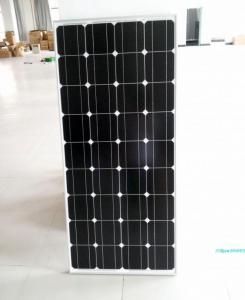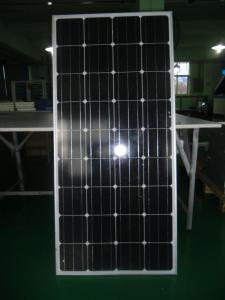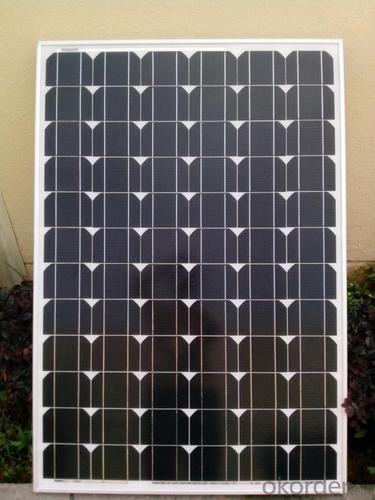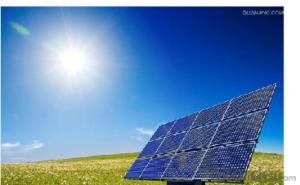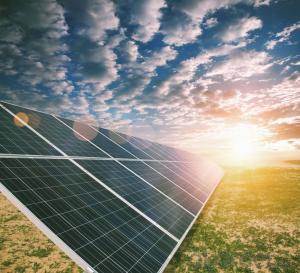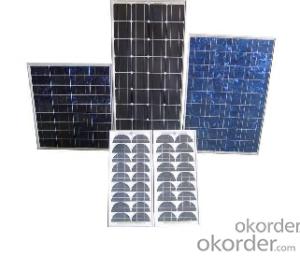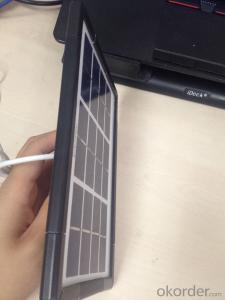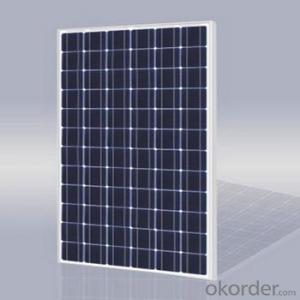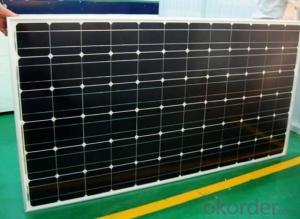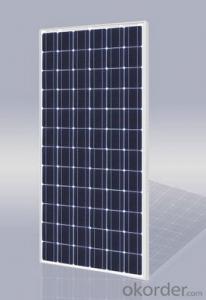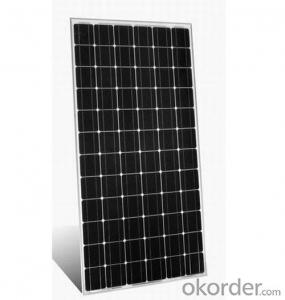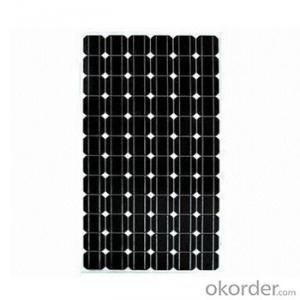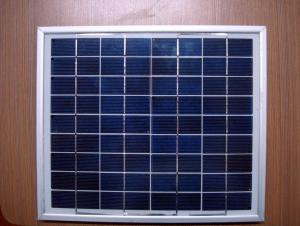700 Watt Solar Monocrystalline Series Panels
- Loading Port:
- Shanghai
- Payment Terms:
- TT
- Min Order Qty:
- 1 watt
- Supply Capability:
- 100000/month watt/month
OKorder Service Pledge
OKorder Financial Service
You Might Also Like
Solar Monocrystalline Series Panels
Introduction of Solar Monocrystalline Series Panels
CNBM Solar photovoltaic (PV) Panel is designed for large electrical power requirements. It is the optimal choice for both on-grid and off-grid power systems. CNBM Solar panel offers high performance of power per square foot of solar array. Monocrystalline silicon(c-Si): often made using the Czochralski process. Single-crystal wafer cells tend to be expensive, and because they are cut from cylindrical ingots, do not completely cover a square solar cell module without a substantial waste of refined silicon. Hence most c-Si panels have uncovered gaps at the four corners of the cells.
Characteristics of Solar Monocrystalline Series Panels
I Solar Cell : High efficiency crystalline solar cell. Even if under the weak light, the solar module can produce maximum power output.
II Tempered glass (toughened glass): Anti-reflecting coating and high transmission rate glass increase the power output and mechanical strength of solar module.
III EVA and TPT: Using high quality EVA and TPT to prevent destroying and water.
IV AI frame: Without screw, corner connection. 6 holes on the frame can be installed easily.
V Junction box: Multi function junction box with water proof.
VI Long lifetime: ≥25 years; Less power decrease
VII Good performance of preventing from atrocious weather such as wind and hails.
VIII Resisting moisture and etching effectively, not effected by geology.
Standard Test Conditions of Solar Monocrystalline Series Panels
The opto-electrical specifications shown below are stabilized values being measured at Standard Test Conditions, Irradiance: 1000W/m2, Spectrum: AM1.5 at 25°C, The info below is subject to manufacturing tolerances. Where appropriate minutes of measurement are available and are used for the dimensioning of the installation.
Advantages of Solar Monocrystalline Series Panels
• CNBM Solar performance guarantees for 25 years
• 12 years guarantee for workmanship
• Timeliness of delivery
CNBM International Corporation's products including Monocrystalline Solar Panel, Polycrystalline Solar Panel have received and enjoyed famous reputation in many countries and regions in the world .As a solar panel supplier in China, we strive to provide our customers with excellent service, superior products and unmatched value.
Characteristics of Solar Monocrystalline Series Panels
Max Power Voltage Vmp (V) | 18.4V | 17.6V |
Max Power Current Imp (A) | 6.52A | 7.39A |
Open Circuit Voltage Voc (V) | 23.0V | 22.2V |
Short Circuit Current Isc (A) | 6.97A | 7.90A |
Max Power Pm (W) | 120W | 130W |
Temperature Coefficient of Cells
NOCT | 47℃±2℃ |
Temperature Coefficients of Isc (%/℃) | 0.064 |
Temperature Coefficients of Voc (%/℃) | -0.33 |
Temperature Coefficients of Pmp (%/℃) | -0.45 |
Mechanical Data Solar Monocrystalline Series
Power | 120W/130W |
Dimension | 1190/1470×670×30mm |
Weight | 9.5kg/11.7kg |
Tolerance | ±3% |
The dimension of the modules can be changed according to the demand of clients
Limits
Operating Temperature | –40 °C to +85°C |
Storage Temperature | –40 °C to +85°C |
Max System Voltage | 700V |
Guarantee Solar Monocrystalline Series Panels
Products Guarantee | 2 yrs free from defects in materials and workmanship |
Performance Guarantee | No less than 90% within 10yrs and no less than 80% within 20yrs |
Certificates | IEC, ISO, TUV, CE |
The Examination of Solar Monocrystalline Series Panels
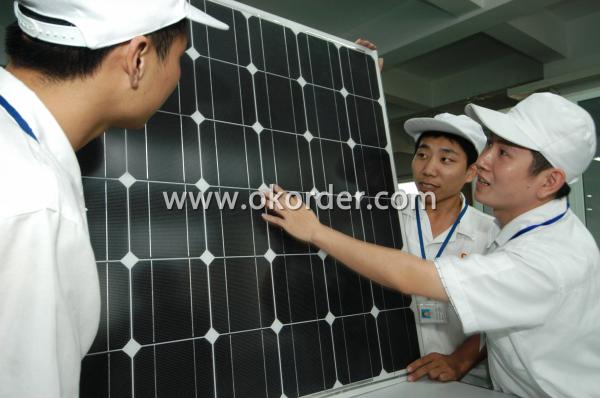
The Usage of Solar Monocrystalline Series Panels
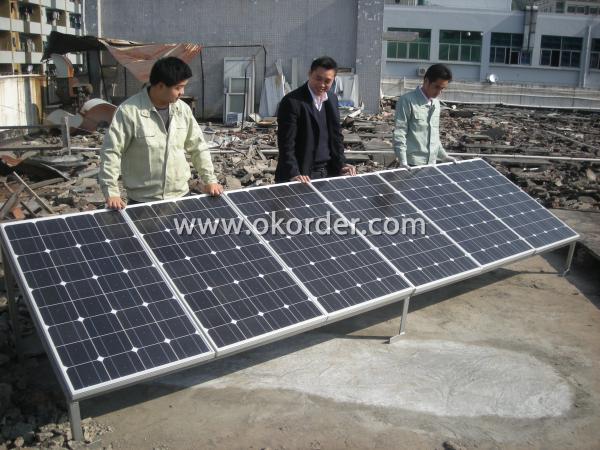
The Equipment in the Production Line of Solar Monocrystalline Series Panels
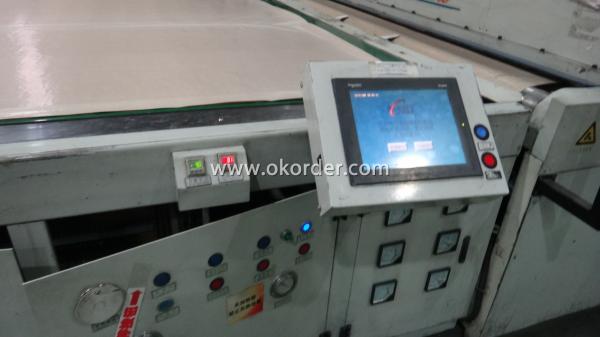
- Q: I know that if I put solar panels in my home I will get 30% back from the govt. Does that mean if I pay 2K I will get back around a 3K check? Or will my income play a roll where I may not get back as much?
- Not a good answer: CNBC had a news bit, that it can take 0 to 20 years for you to break even in energy costs after installing solar panels. Please don't buy them just for the tax deduction. See if you can google a calculator for this - do research. I have a brother in law that buys anything under the sun just because he gets a tax deduction. I'm sure you're not like that though. Run the numbers of what you will save vs the 2K you will spend You may never break even
- Q: Where can I find updated info about solar panels for home?
- Check out this article. Thin film panels are the latest and greatest.
- Q: Are there any health risks associated with solar panels?
- No, there are no significant health risks associated with solar panels. Solar panels do not emit any harmful substances or pollutants that could pose a threat to human health. However, it is important to handle and install them properly to avoid any potential accidents or injuries.
- Q: Single crystal solar panels and polycrystalline solar panels
- monocrystalline silicon market share and a slight increase, and now the market to see the majority of single-crystal silicon cells. Monocrystalline silicon solar cell silicon crystal is very perfect, its optical, electrical and mechanical properties are very uniform, the color of the battery is mostly black or dark, especially for small pieces of small pieces of consumer products.
- Q: How much electricity can a solar panel produce?
- The amount of electricity a solar panel can produce depends on several factors, such as its size, efficiency, and the amount of sunlight it receives. On average, a standard solar panel can generate anywhere from 250 to 400 watts of electricity per hour. However, larger and more efficient panels, combined with optimal sunlight conditions, can potentially produce even more electricity.
- Q: Do solar panels require a backup generator?
- No, solar panels do not require a backup generator. They generate electricity directly from sunlight and can store excess energy in batteries for use when the sun is not shining.
- Q: Can I make a solar panel at home?How to make it?
- It's not necessary. The time, materials, energy, and money you have to put out might not be worth it. Being this is your first unit, there are cheap enough panels; you should shop around. OKorder alone with an array of selections and there is Home Depot and others. When solar panels not hooked up correctly or you don't have the right equipment you can cause the batteries to explode. Do your research there's plenty on Youtube. I'd read the answers here but you really need to do some homework elsewhere. It is that serious that I wouldn't give any advise on the how to.
- Q: I have an inverter and a battery 20 Amperes.Daily sun shine approx. 7 Hours.Do I need to buy anything or should I connect the solar panel to the Battery direct?
- No, don't connect the panel directly to the battery. You need to isolate the solar panel charging output from the AC-powered charger. A couple of high-current diodes arranged with their anodes connected to the charging sources in the positive supply line will allow either the charger or the solar panel to lift the voltage high enough to charge the battery, albeit with about 0.6 volts dropped across the diode. Both cathode ends would be connected to the battery. This arrangement allows a positive current to flow from either or both charging sources at the same time, although in practice, one will generally be higher than the other. Also, if the AC charger's voltage is significantly higher than the solar panel, the charger may always charge the battery. You would need to regulate its output to be slightly lower than the solar panel when it's near it's minimum useful operating voltage. (note that the 0.6 forward bias voltage on the diode might prevent the solar panel from completely charging the battery if it has any voltage regulation on its output)
- Q: first of all, to be honest i have totally no idea on how a solar panel works.my task is to design something like a solar powered street lamp which store sun energy during day time and convert it into electrical energy then light energy so that the lamp can work during night time.any ideas on how to design the solar panel? which can store enough or more enegry in case there is no sunlight another day. and low cost as well :D
- solar panels are designed to charge 2v batteries, now depending on the power you need you can determine what kind to use there are many power ratings for the modules, for example if you want to charge two 2v batteries you can connect them in parallel, if you want to reduce the charging time you can use more than one module in parallel to increase the power.
- Q: So I reckon it's time to install some of these bad boys. it's come to point where electricity providers are charging such extortionate amounts that I can definitely see these reaping huge rewards before long. (Okay I might be exaggerating a little - they are pretty costly themselves).The problem is I've read around that they're only fitted to south facing houses? Why so? Why can't they be installed on the rear side of the roof - the side facing the garden? My house is facing north, so the front door leads north. Could I have solar panels installed on the back? (That's basically my question, with a bit of a rant too lol).Cheers.
- You want the panels facing south because that is where they would get the most sunlight throughout the day. If your front door is facing north, then the back of your house would be facing south, right? So put them up in the back where they are facing south...haha wtf..
Send your message to us
700 Watt Solar Monocrystalline Series Panels
- Loading Port:
- Shanghai
- Payment Terms:
- TT
- Min Order Qty:
- 1 watt
- Supply Capability:
- 100000/month watt/month
OKorder Service Pledge
OKorder Financial Service
Similar products
Hot products
Hot Searches
Related keywords

